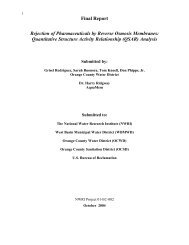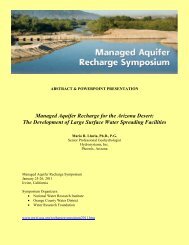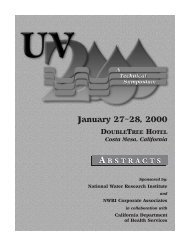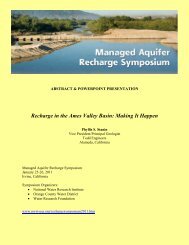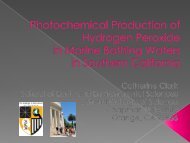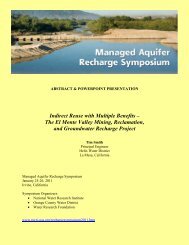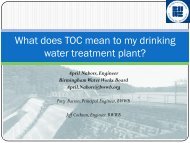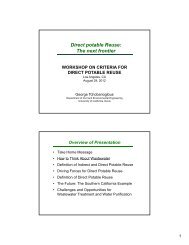Chlorine dioxide decay and ClO 2
Chlorine dioxide decay and ClO 2
Chlorine dioxide decay and ClO 2
You also want an ePaper? Increase the reach of your titles
YUMPU automatically turns print PDFs into web optimized ePapers that Google loves.
Hrvoje JURETIĆ, Ph.D.<br />
University of Zagreb, Faculty of Mechanical<br />
Engineering <strong>and</strong> Naval Architecture<br />
hrvoje.juretic@fsb.hr<br />
Comparison of Disinfection Byproducts<br />
from Using <strong>Chlorine</strong> <strong>and</strong> <strong>Chlorine</strong> Dioxide<br />
in Drinking Water Distribution Systems<br />
Fourth IWA Specialty Conference on Natural Organic Matter: From Source to Tap <strong>and</strong> Beyond<br />
July 27, 2011, Costa Mesa, California<br />
1
Background, aim <strong>and</strong> scope<br />
Microbiological safety of drinking water is generally achieved<br />
by treating the water with a chemical disinfectant such as<br />
chlorine, chlorine <strong>dioxide</strong> <strong>and</strong> ozone.<br />
Despite the well-known problems of undesired DBPs formation,<br />
chlorination is still the most widely used method of disinfection.<br />
n.<br />
Trihalomethanes (THMs)) have been found to be the most<br />
prevalent organic contaminants after drinking water chlorination<br />
<strong>and</strong> typically occur at higher concentrations than other<br />
disinfection by-products.<br />
THMs <strong>and</strong> chlorites are the only regulated DBPs in Croatia. . The<br />
sum of four THMs is limited to a maximum value of 100 µg g L -1 ,<br />
while the MCL for chlorite is set at 400 µg g L -1 .<br />
2
There is a pressing need to examine alternative<br />
disinfectants to chlorine in order to reduce potential<br />
health risks.<br />
<strong>Chlorine</strong> <strong>dioxide</strong> (<strong>ClO</strong> 2 ) is widely used as an<br />
alternative disinfectant because it does not produce<br />
appreciable levels of THMs (some possible<br />
hazardous by-products, including chlorite <strong>and</strong><br />
chlorate are produced).<br />
Information such as reaction rate constants <strong>and</strong> by-<br />
products formation can be used as important factors<br />
in determining whether disinfection with <strong>ClO</strong> 2 are<br />
suitable for the decreasing unwanted by-products.<br />
3
The aim of the study was to evaluate what impact the<br />
switch from chlorine to chlorine <strong>dioxide</strong> would have on<br />
the concentration of the major DBPs in groundwater<br />
samples from the Eastern Slavonia region, Croatia <strong>and</strong><br />
to compare these two disinfectants by performing<br />
mutagenicity testing.<br />
This is the first study of this kind in Croatia <strong>and</strong> is<br />
associated with the development of the Eastern Slavonia<br />
Regional Water Supply System with a design flow rate of<br />
2000 L s -1 .<br />
4
For this purpose we examined:<br />
<br />
<br />
<br />
<br />
THMFP<br />
<strong>Chlorine</strong> <strong>decay</strong> <strong>and</strong> THMs formation during<br />
chlorination<br />
<strong>Chlorine</strong> <strong>dioxide</strong> <strong>decay</strong> <strong>and</strong> formation of<br />
chlorite during the treatment of groundwater<br />
samples with <strong>ClO</strong> 2<br />
Short-term<br />
term mutagenicity test (Comet assay<br />
on isolated human lymphocytes)<br />
5
Materials <strong>and</strong> Methods<br />
Water Samples<br />
Groundwater samples were collected from three locations throughout ut the<br />
Eastern Slavonia region.<br />
Parameter SIK RET OSI<br />
pH 8.28 7.85 7.94<br />
Conductivity (μS cm -1 ) 414 659 751<br />
Alkalinity (mg L -1 as CaCO 3 ) 182 258 330<br />
Hardness (mg L -1 as CaCO 3 ) 196 161 207<br />
UV 254 , cm -1 0.017 0.073 0.104<br />
NPOC (mg L -1 ) 0.27 2.03 3.06<br />
TN (mg L -1 ) 0.12 0.67 1.76<br />
THMFP (µg L -1 as CHCl 3 ) 12.9 78.1 80.4<br />
Bromide (μg L -1 ) 5 36 7.5<br />
Chloride (mg L -1 ) 4.4 21.6 15.5<br />
Sulfate (mg L -1 ) 11.4 10.4 3.94<br />
Phosphate (mg L -1 P) 0.025 0.097<br />
As (μg L -1 ) 2.33 35.7 26.9<br />
Fe (μg L -1 ) 15 4.14 4.2<br />
Mn (μg L -1 ) 37 136 20.9<br />
6
Analytical Methods<br />
A chlorine stock solution was prepared by dissolving chlorine gas into Milli-<br />
Q water <strong>and</strong> st<strong>and</strong>ardized spectrophotometrically by using a molar absorption<br />
coefficient of the triiodide ion, calculated to be 25,024 M -1 cm -1 at 351 nm.<br />
A chlorine <strong>dioxide</strong> stock solution was prepared by adding dilute H 2 SO 4 to a<br />
sodium chlorite solution according to St<strong>and</strong>ard Method 4500-<strong>ClO</strong><br />
2 B (APHA<br />
et al., 1995) <strong>and</strong> st<strong>and</strong>ardized by the direct spectrophotometrical<br />
determination of <strong>ClO</strong> 2 at 360 nm using a calculated absorption coefficient of<br />
1182 M -1 cm -1 .<br />
The bulk chlorine <strong>decay</strong> rates were measured by absorbance measurement<br />
at 351 nm using a Hewlett Packard 8453 UV-visible spectrophotometer.<br />
The bulk chlorine <strong>dioxide</strong> <strong>decay</strong> rates were determined according to US<br />
EPA Method 327.0 Rev. 1.1 by measurement the absorbance difference<br />
between the reagent water blank <strong>and</strong> the samples at 633 nm, which is the<br />
absorbance maximum for Lissamine Green B (LGB) in the citric acid/glycine<br />
buffer.<br />
7
Analytical Methods<br />
The THMs analysis was carried out on HS/GC/MS according to the EPA<br />
Method 8260b .<br />
Chlorite concentrations were calculated after the samples are sparged to<br />
remove chlorine <strong>dioxide</strong> according to US EPA Method 327.0 Rev. 1.1.<br />
THMFP was determined according to St<strong>and</strong>ard Method 5710 B (APHA et<br />
al., 1995).<br />
Alkaline comet assay was carried out according to Singh et al. (1988).<br />
Blood sample was used for the isolation of lymphocytes. Total of 300<br />
comets per sample were measured (100 comets per each of three replicate<br />
slides). As a measure of DNA damage we evaluated the tail intensity<br />
ity<br />
(DNA% in the comet tail).<br />
8
SIK_15<br />
5<br />
<strong>Chlorine</strong>_HD<br />
<strong>Chlorine</strong>_LD<br />
4<br />
3<br />
2<br />
1<br />
0<br />
0 20 40 60 80 100 120<br />
9<br />
Residual chlorine concentration (mg L -1 )<br />
Time (h)<br />
25<br />
20<br />
TTHM (µg L -1 as CHCl3 )<br />
Results <strong>Chlorine</strong> <strong>decay</strong> <strong>and</strong> THMs formation<br />
TTHM_HD<br />
TTHM_LD<br />
15<br />
10<br />
5<br />
0
Results <strong>Chlorine</strong> <strong>decay</strong> <strong>and</strong> THMs formation<br />
5<br />
<strong>Chlorine</strong>_HD<br />
<strong>Chlorine</strong>_LD<br />
4<br />
3<br />
2<br />
1<br />
15<br />
10<br />
5<br />
0<br />
0 20 40 60 80 100 120<br />
10<br />
Residual chlorine concentration (mg L -1 )<br />
TTHM (µg L -1 as CHCl3 )<br />
SIK_25<br />
20<br />
TTHM_HD<br />
TTHM_LD<br />
0<br />
Time (h)
Results <strong>Chlorine</strong> <strong>decay</strong> <strong>and</strong> THMs formation<br />
5<br />
4<br />
3<br />
2<br />
1<br />
<strong>Chlorine</strong>_HD<br />
<strong>Chlorine</strong>_LD<br />
0<br />
0 5 10 15 20 25<br />
11<br />
Residual chlorine concentration (mg L -1 )<br />
Time (h)<br />
50<br />
40<br />
TTHM (µg L -1 as CHCl3 )<br />
RET_15<br />
TTHM_HD<br />
TTHM_LD<br />
30<br />
20<br />
10<br />
0
Results<br />
<strong>Chlorine</strong> <strong>decay</strong> <strong>and</strong> THMs formation<br />
RET_25<br />
2.5<br />
60<br />
<strong>Chlorine</strong>_HD<br />
<strong>Chlorine</strong>_LD<br />
Residual chlorine concentration (mg L -1 )<br />
2.0<br />
1.5<br />
1.0<br />
0.5<br />
0.0<br />
TTHM_HD<br />
TTHM_LD<br />
50<br />
40<br />
30<br />
20<br />
10<br />
TTHM (µg L -1 as CHCl 3<br />
)<br />
0<br />
0 5 10 15 20 25<br />
Time (h)<br />
12
Results <strong>Chlorine</strong> <strong>decay</strong> <strong>and</strong> THMs formation<br />
OSI_15<br />
4<br />
3<br />
2<br />
1<br />
<strong>Chlorine</strong>_HD<br />
<strong>Chlorine</strong>_LD<br />
0<br />
0 20 40 60 80 100 120<br />
13<br />
Residual chlorine concentration (mg L -1 )<br />
TTHM (µg L -1 as CHCl3 )<br />
50<br />
40<br />
TTHM_HD<br />
TTHM_LD<br />
30<br />
20<br />
10<br />
0<br />
Time (h)
Results <strong>Chlorine</strong> <strong>decay</strong> <strong>and</strong> THMs formation<br />
OSI_25<br />
4<br />
3<br />
2<br />
1<br />
<strong>Chlorine</strong>_HD<br />
<strong>Chlorine</strong>_LD<br />
0<br />
0 20 40 60 80 100 120<br />
14<br />
Residual chlorine concentration (mg L -1 )<br />
TTHM (µg L -1 as CHCl3 )<br />
50<br />
TTHM_HD<br />
40<br />
30<br />
20<br />
10<br />
0<br />
Time (h)
Results<br />
<strong>Chlorine</strong> <strong>dioxide</strong> <strong>decay</strong> <strong>and</strong> <strong>ClO</strong> 2- formation<br />
SIK_15<br />
3.0<br />
1.0<br />
Residual chlorine <strong>dioxide</strong> concentration (mg L -1 )<br />
2.5<br />
2.0<br />
1.5<br />
1.0<br />
0.5<br />
<strong>Chlorine</strong> <strong>dioxide</strong>_HD<br />
<strong>Chlorine</strong> <strong>dioxide</strong>_LD<br />
Chlorite_HD<br />
Chlorite_LD<br />
0.9<br />
0.8<br />
0.7<br />
0.6<br />
0.5<br />
0.4<br />
0.3<br />
0.2<br />
0.1<br />
Chlorite concentration (mg L -1 )<br />
0.0<br />
0 20 40 60 80 100 120<br />
0.0<br />
Time (h)<br />
15
Results<br />
<strong>Chlorine</strong> <strong>dioxide</strong> <strong>decay</strong> <strong>and</strong> <strong>ClO</strong> 2- formation<br />
SIK_25<br />
Residual chlorine <strong>dioxide</strong> concentration (mg L -1 )<br />
2.5<br />
2.0<br />
1.5<br />
1.0<br />
0.5<br />
<strong>Chlorine</strong> <strong>dioxide</strong>_HD<br />
<strong>Chlorine</strong> <strong>dioxide</strong>_LD<br />
Chlorite_HD<br />
Chlorite_LD<br />
1.0<br />
0.9<br />
0.8<br />
0.7<br />
0.6<br />
0.5<br />
0.4<br />
0.3<br />
0.2<br />
0.1<br />
Chlorite concentration (mg L -1 )<br />
0.0<br />
0 20 40 60 80 100 120<br />
0.0<br />
Time (h)<br />
16
Results<br />
<strong>Chlorine</strong> <strong>dioxide</strong> <strong>decay</strong> <strong>and</strong> <strong>ClO</strong> 2- formation<br />
RET_15<br />
Residual chlorine <strong>dioxide</strong> concentration (mg L -1 )<br />
2.0<br />
1.6<br />
1.2<br />
0.8<br />
0.4<br />
0.0<br />
<strong>Chlorine</strong> <strong>dioxide</strong>_HD<br />
<strong>Chlorine</strong> <strong>dioxide</strong>_LD<br />
Chlorite_HD<br />
Chlorite_LD<br />
2.0<br />
1.6<br />
1.2<br />
0.8<br />
0.4<br />
Chlorite concentration (mg L -1 )<br />
0 20 40 60 80 100 120<br />
Time (h)<br />
0.0<br />
17
Results<br />
<strong>Chlorine</strong> <strong>dioxide</strong> <strong>decay</strong> <strong>and</strong> <strong>ClO</strong> 2- formation<br />
RET_25<br />
Residual chlorine <strong>dioxide</strong> concentration (mg L -1 )<br />
1.8<br />
1.6<br />
1.4<br />
1.2<br />
1.0<br />
0.8<br />
0.6<br />
0.4<br />
0.2<br />
0.0<br />
<strong>Chlorine</strong> <strong>dioxide</strong>_HD<br />
<strong>Chlorine</strong> <strong>dioxide</strong>_LD<br />
Chlorite_HD<br />
Chlorite_LD<br />
2.0<br />
1.6<br />
1.2<br />
0.8<br />
0.4<br />
Chlorite concentration (mg L -1 )<br />
-0.2<br />
0 10 20 30 40 50<br />
Time (h)<br />
0.0<br />
18
Results<br />
<strong>Chlorine</strong> <strong>dioxide</strong> <strong>decay</strong> <strong>and</strong> <strong>ClO</strong> 2- formation<br />
OSI_15<br />
1.2<br />
2.0<br />
Residual chlorine <strong>dioxide</strong> concentration (mg L -1 )<br />
1.0<br />
0.8<br />
0.6<br />
0.4<br />
0.2<br />
0.0<br />
<strong>Chlorine</strong> <strong>dioxide</strong>_HD<br />
<strong>Chlorine</strong> <strong>dioxide</strong>_LD<br />
Chlorite_HD<br />
Chlorite_LD<br />
1.6<br />
1.2<br />
0.8<br />
0.4<br />
Chlorite concentration (mg L -1 )<br />
-0.2<br />
0 10 20 30 40 50<br />
0.0<br />
Time (h)<br />
19
Results<br />
<strong>Chlorine</strong> <strong>dioxide</strong> <strong>decay</strong> <strong>and</strong> <strong>ClO</strong> 2- formation<br />
OSI_25<br />
2.0<br />
Residual chlorine <strong>dioxide</strong> concentration (mg L -1 )<br />
0.8 <strong>Chlorine</strong> <strong>dioxide</strong>_HD<br />
<strong>Chlorine</strong> <strong>dioxide</strong>_LD<br />
Chlorite_HD<br />
Chlorite_LD<br />
0.6<br />
0.4<br />
0.2<br />
0.0<br />
1.6<br />
1.2<br />
0.8<br />
0.4<br />
Chlorite concentration (mg L -1 )<br />
0 5 10 15 20 25<br />
0.0<br />
Time (h)<br />
20
<strong>Chlorine</strong> <strong>decay</strong> parameters<br />
Water<br />
samples<br />
SIK_15<br />
SIK_25<br />
RET_15<br />
RET_25<br />
OSI_15<br />
OSI_25<br />
<strong>Chlorine</strong><br />
dose<br />
a (mgL -1 ) b (mgL -1 ) k (h -1 ) r 2<br />
HD 3.874 0.4745 0.0375 0.96<br />
LD 1.681 0.3695 0.0740 0.88<br />
HD 3.436 0.4641 0.0371 0.97<br />
LD 1.447 0.3835 0.0391 0.96<br />
HD 2.499 1.2176 0.2145 0.96<br />
LD 0.725 0.8683 0.3681 0.95<br />
HD 0.178 1.1294 0.2762 0.89<br />
LD 0.440 0.3535 0.2650 0.99<br />
HD 0.414 2.0086 0.0475 0.96<br />
LD 0.177 1.2077 0.5256 0.98<br />
HD 0 1.8581 0.0491 0.99<br />
LD 0 0.7345 0.1405 0.80<br />
C t = a + b × exp(-kt)<br />
21
Water<br />
samples<br />
SIK_15<br />
SIK_25<br />
RET_15<br />
RET_25<br />
OSI_15<br />
OSI_25<br />
<strong>Chlorine</strong> <strong>dioxide</strong> <strong>decay</strong> parameters<br />
<strong>Chlorine</strong><br />
<strong>dioxide</strong> a (mgL -1 ) b (mgL -1 ) k (h -1 ) r 2<br />
dose<br />
HD 2.031 0.4336 0.0250 0.97<br />
LD 1.041 0.1448 0.0187 0.91<br />
HD 1.683 0.6260 0.0178 0.96<br />
LD 0.885 0.2424 0.0262 0.90<br />
HD 0 1.6549 0.0583 0.98<br />
LD 0 0.4858 0.4999 0.99<br />
HD 0 1.5335 0.1444 0.99<br />
LD 0 0.7006 3.9047 0.99<br />
HD 0 1.0084 0.3398 0.99<br />
LD 0 0.0872 3.7007 0.99<br />
HD 0 0.7644 0.6229 0.98<br />
LD 0.019 0.0123 0.1076 0.99<br />
C t = a + b × exp(-kt)<br />
22
THMFP<br />
Trihalomethane Formation Potential<br />
100<br />
THM (µg L -1 as CHCl3)<br />
80<br />
60<br />
40<br />
20<br />
Tribromomethane<br />
Dibromochloromethane<br />
Bromodichloromethane<br />
Trichloromethane<br />
0<br />
SIK OSI RET<br />
Test water<br />
23
Results<br />
8<br />
7<br />
6<br />
5<br />
4<br />
3<br />
2<br />
1<br />
0<br />
Genotoxicity<br />
Control Raw water <strong>ClO</strong>2 Cl2<br />
Sik<br />
Ret<br />
Osi<br />
24
Conclusions<br />
In all of the treated water samples the TTHM concentration never<br />
exceed the maximum permissible value of 100 µg L -1 , while for some<br />
waters the observed chlorite concentrations exceeded the MCL.<br />
Different chlorine dem<strong>and</strong> may be attributed to different content<br />
<strong>and</strong> nature of dissolved organic matter in water samples used in this<br />
study. The experimental kinetic data could be used to predict the<br />
chlorine/chlorine <strong>dioxide</strong> dem<strong>and</strong> <strong>and</strong> TTHM formation at any time in a<br />
distribution system.<br />
It should be noted that the chlorine/chlorine <strong>dioxide</strong> dem<strong>and</strong> of<br />
water samples measured in the laboratory differ from the actual<br />
disinfectant dem<strong>and</strong> in a distribution system. Factors such as<br />
reactions of chlorine/chlorine <strong>dioxide</strong> with biofilms <strong>and</strong> with pipe walls<br />
have not been investigated in our laboratory experiments.<br />
25
Conclusions<br />
Relatively low bromide level in all water samples is the reason for<br />
typically very low concentration of brominated THMs .<br />
Other classes of DBPs have not been investigated – further<br />
research is needed!<br />
Low genotoxic potency of all water samples was observed (no prior<br />
extraction)<br />
26



